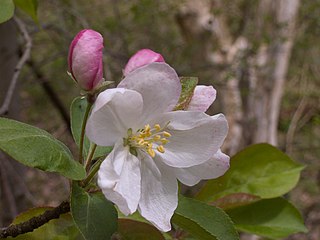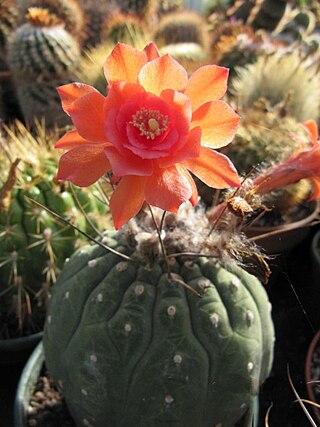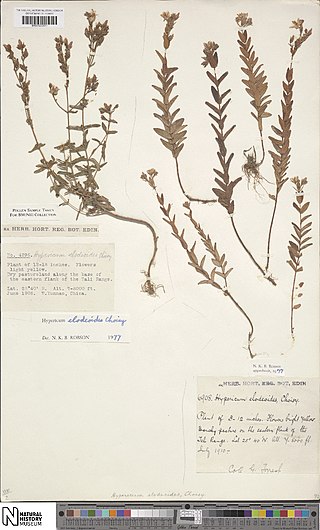
Malus coronaria, also known by the names sweet crabapple or garland crab, is a North American species of Malus (crabapple).

Ribes canthariforme is a rare species of currant commonly known as the Moreno currant. It is characterized by pink to red flowers, a dense inflorescence, and a lack of nodal spines. A little-known endemic to the mountains of San Diego County, it is usually found growing the shade of massive boulders in the chaparral. Although the rarity and small numbers of this plant is a conservation concern, it is usually found in remote areas and is well hidden enough to be safe from most threats.

Eutaxia parvifolia is a species of flowering plant in the family Fabaceae and is endemic to southwestern Western Australia. It is a shrub with reddish brown stems, elliptic to egg-shaped leaves with the narrower end towards the base, and mostly yellow, red or orange flowers, with yellow red or orange markings.
Urtica lalibertadensis is a species of the genus Urtica. It differs from U. leptostachya in its subscandent habit and the deflexed stinging hairs on the glabrous stem, and by the presence of numerous stinging hairs on the perigon of the female flowers and individual stinging hairs on the perigon of the male flower. It is a very abundant species in Peru.
Urtica urentivelutina is a species of the genus Urtica. This species is closely related to U. macbridei, but differs in its much denser and longer indument, especially on the stipules and the presence of stinging hairs on the perigon of the female flowers. The leaves are densely pubescent and also irregularly bullate between the veins, which is a character not found in other Peruvian species.
Ribes sanchezii is a species of currant, named after Peruvian botanist Isidoro Sánchez Vega of Cajamarca. This species of Ribes is distinct form both R. andicola and R. colandina because of its ovate to elliptical leaves with a very poorly developed lateral lobe and its aberrant indument. The two latter species have leaves with pubescence on both the adaxial and abaxial surface and the adaxial leaf surface is matt green, whereas R. sanchezii has a shiny dark green upper leaf surface and pubescence abaxially restricted to the primary and secondary veins. Ribes sanchezii also has strongly resupinate fruits, whereas the fruits of R. andicola and R. colandina are pendulous.
Ribes contumazensis is a species of currant, named after Peruvian botanist Isidoro Sánchez Vega of Cajamarca. It is completely glabrous apart from the stalked glands, differentiating it from R. colandina.

Prostanthera saxicola is a species of flowering plant in the family Lamiaceae and is endemic to eastern Australia. It is a shrub with linear to elliptic leaves and white to mauve flowers arranged in leaf axils.

Matucana aurantiaca is a species of flowering plant in the cactus family Cactaceae. It grows in the Cajamarca and La Libertad regions of Peru. It is considered to have a stable population and a wide range with no threats.

Darwinia apiculata, commonly known as the scarp darwinia, is a plant in the myrtle family Myrtaceae and is endemic to a small area in Western Australia. It is a rounded, densely branched, small shrub with thin red branches and scattered small leaves. The flowers are arranged in small groups on the ends of the branches, their most obvious feature being long, red, pointed bracts surrounding each flower and a longer red style with scattered hairs near its tip.
Calytrix gracilis is a species of flowering plant in the myrtle family Myrtaceae and is endemic to the south-west of Western Australia. It is a glabrous shrub with linear leaves and scattered violet to deep blue flowers, with about 65 to 125 white to yellow stamens in several rows, becoming reddish as they age.

Calytrix oldfieldii is a species of flowering plant in the myrtle family Myrtaceae and is endemic to the south-west of Western Australia. It is a glabrous shrub with linear, oblong or egg-shaped leaves and mauve, pink, red, magenta or violet flowers with about 50 to 75 yellow stamens in several rows.
Micromyrtus papillosa is a species of flowering plant in the family Myrtaceae and is endemic to the south-west of Western Australia. It is sometimes an erect or low, otherwise spreading shrub with egg-shaped leaves with the narrower end towards the base, and white flowers with 5 stamens.
Micromyrtus uniovulum is a species of flowering plant in the family Myrtaceae and is endemic to a small area in the south-west of Western Australia. It is a low, spreading, sometimes erect shrub with oblong leaves, and white flowers with 10 stamens.
Hypericum cuisinii is a perennial herb in the genus Hypericum, in the section Adenosepalum. The herb has pale yellow flowers and occurs in Greece and Turkey.

Bossiaea brownii is a species of flowering plant in the family Fabaceae and is endemic to eastern Queensland. It is an erect shrub with egg-shaped leaves and yellow flowers with red markings.

Hypericum undulatum, the wavy St Johns Wort, is a herbaceous perennial flowering plant native to western Europe and northern Africa. The specific name undulatum is Latin, meaning "wavy" or "undulated", referring, just as the common name, to the wavy leaf margins of the herb. The plant has a diploid number of 16 or 32.
Hibbertia depilipes is a species of flowering plant in the family Dilleniaceae and is endemic to the far south-west of Western Australia. It is usually a sprawling shrub with scattered linear leaves and yellow flowers arranged singly in leaf axils usually with ten stamens all on one side of the two carpels.

Hypericum elodeoides, commonly called the Himalayan St. John's Wort, is a species of flowering plant of the St. John's wort family (Hypericaceae).

Senna cardiosperma is a species of flowering plant in the family Fabaceae and is endemic to the western half of Australia. It is an erect shrub or small tree with pinnate leaves, the number and shape of the leaflets depending on subspecies, yellow flowers with ten fertile stamens in each flower, and flat pods.










